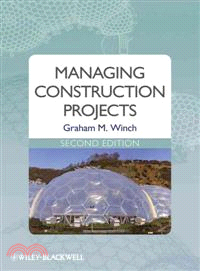Managing Construction Projects 2E
商品資訊
相關商品
商品簡介
作者簡介
名人/編輯推薦
目次
商品簡介
Project management is of critical importance in construction, yet its execution poses major challenges. In order to keep a project on track, decisions often have to be made before all the necessary information is available.
Drawing on a wide range of research, Managing Construction Projects proposes new ways of thinking about project management in construction, exploring the skills required to manage uncertainty and offering techniques for thinking about the challenges involved. The second edition takes the information processing perspective introduced in the first edition and develops it further. In particular, this approach deepens the reader’s understanding of the dynamics in the construction project process – from the value proposition inherent in the project mission, to the functioning asset that generates value for its owners and users.
Managing Construction Projects is a unique and indispensible contribution to the available literature on construction project management. It will be of particular benefit to advanced students of construction and construction project management, as well as contractors and quantity surveyors.
Reviews of the First edition:
"A massive review of the art and science of the management of projects that has the great virtue of being a good read wherever it is touched. It spills the dirt on things that went wrong, elucidates the history so you can understand the industry's current stance, draws on other countries experience and explains the latest management processes. Throughout it is liberally sprinkled with anecdotes and case histories which amply illustrate the dos and don't for practitioners wishing to deliver projects on time to expected quality and price. A valuable book for students and practitioners alike."
—John D Findlay, Director, Stent
"This is a valuable source for practitioners and students. It covers the A-Z of project management in a confident contemporary manner, and provides a powerful and much needed conceptual perspective in place of a purely prescriptive approach. The engaging presentation introduces a range of challenges to established thinking about project management, often by making comparisons between practices in the UK and those of other countries."
—Peter Lansley, Professor of Construction Management, University of Reading
"A refreshing and unique study of information management and its impact upon international construction project management.... The book is well presented and written, logical and succinct and is flexible enough to allow readers to either read from start to finish or to dip into selected chapters. This book deserves to be an established text for any construction or civil engineering under - and/or postgraduate course."
—CNBR, 25th November 2003
"Generous use is made of anecdotes andc case histories throughout to support the theory. the book illustrates the mistakes made by others, and the means to deliver projects on time and to cost."
—Building Services Journal, April 2004
Drawing on a wide range of research, Managing Construction Projects proposes new ways of thinking about project management in construction, exploring the skills required to manage uncertainty and offering techniques for thinking about the challenges involved. The second edition takes the information processing perspective introduced in the first edition and develops it further. In particular, this approach deepens the reader’s understanding of the dynamics in the construction project process – from the value proposition inherent in the project mission, to the functioning asset that generates value for its owners and users.
Managing Construction Projects is a unique and indispensible contribution to the available literature on construction project management. It will be of particular benefit to advanced students of construction and construction project management, as well as contractors and quantity surveyors.
Reviews of the First edition:
"A massive review of the art and science of the management of projects that has the great virtue of being a good read wherever it is touched. It spills the dirt on things that went wrong, elucidates the history so you can understand the industry's current stance, draws on other countries experience and explains the latest management processes. Throughout it is liberally sprinkled with anecdotes and case histories which amply illustrate the dos and don't for practitioners wishing to deliver projects on time to expected quality and price. A valuable book for students and practitioners alike."
—John D Findlay, Director, Stent
"This is a valuable source for practitioners and students. It covers the A-Z of project management in a confident contemporary manner, and provides a powerful and much needed conceptual perspective in place of a purely prescriptive approach. The engaging presentation introduces a range of challenges to established thinking about project management, often by making comparisons between practices in the UK and those of other countries."
—Peter Lansley, Professor of Construction Management, University of Reading
"A refreshing and unique study of information management and its impact upon international construction project management.... The book is well presented and written, logical and succinct and is flexible enough to allow readers to either read from start to finish or to dip into selected chapters. This book deserves to be an established text for any construction or civil engineering under - and/or postgraduate course."
—CNBR, 25th November 2003
"Generous use is made of anecdotes andc case histories throughout to support the theory. the book illustrates the mistakes made by others, and the means to deliver projects on time and to cost."
—Building Services Journal, April 2004
作者簡介
Graham Winch is Professor of Project Management, Director of the Centre for Research in the Management of Projects, Director of the BP Managing Projects executive education programme and Head of the Decision Sciences and Operations Management Subject Area Group at Manchester Business School, University of Manchester.
名人/編輯推薦
"This outstanding book is a 'bible' for Construction/Project Managers and deserves a place on the book shelves of libraries of Universities offering courses for the Built Environment." (Building Engineer, June 2010)
目次
Preface to 1st Edition.
Preface to 2nd Edition.
Part I Introduction.
1 The Management of Construction Projects.
1.1 Introduction.
1.2 Projects as the creation of new value.
1.3 The project as an information processing system.
1.4 Project management and the management of projects.
1.5 Projects and resource bases.
1.6 The five generic project processes.
1.7 Critiques of the first edition.
1.8 A theoretical perspective on managing construction projects.
1.9 A practical contribution to managing construction projects.
1.10 The plan of the book.
1.11 Summary.
Case 1 The Channel Fixed Link.
2 The Context of Construction Project Management.
2.1 Introduction.
2.2 The industry recipe for construction.
2.3 National business systems in construction.
2.4 The regulatory context.
2.5 The construction cycle.
2.6 The development of concession contracting.
2.7 Summary.
Case 2 The UK Construction Business System.
Further reading.
Part II Defining the Project Mission.
3 Deciding What the Client Wants.
3.1 Introduction.
3.2 From artefact to asset: facilities as new value.
3.3 Understanding spatial quality and business processes.
3.4 Indoor environmental quality and business processes.
3.5 Symbolic quality: beyond peer review.
3.6 Justifying the investment.
3.7 Strategic misrepresentation in investment appraisal.
3.8 Defining the project mission: a conceptual framework for product integrity.
3.9 Summary.
Case 3 Defining the Mission at the University of York.
Further reading.
4 Managing Stakeholders.
4.1 Introduction.
4.2 Which are the project stakeholders?
4.3 Mapping stakeholders.
4.4 The regulatory context.
4.5 Managing consent.
4.6 Ethics in project mission definition.
4.7 The role of visualisation.
4.8 Summary.
Case 4 The Rebuilding of Beirut Central District.
Further reading.
Part III Mobilising the Resource Base.
5 Forming the Project Coalition.
5.1 Introduction.
5.2 The principal/agent problem in construction.
5.3 Procuring construction services.
5.4 The formation of project coalitions.
5.5 Selecting resource bases.
5.6 Forming more effective project coalitions.
5.7 The development of e-procurement.
5.8 Probity in procurement.
5.9 Summary.
Case 5 Partnering Between Marks & Spencer and Bovis.
Further reading.
6 Motivating the Project Coalition.
6.1 Introduction.
6.2 The problem of moral hazard in construction projects.
6.3 The problem of switching costs.
6.4 Managing the problem of moral hazard.
6.5 Contractual uncertainty and risk allocation.
6.6 Governing the contract and the role of third parties.
6.7 The dynamic of adversarial relations.
6.8 Alliancing.
6.9 Summary.
Case 6 NHS ProCure 21.
Further reading.
7 Managing the Dynamics of the Supply Chain.
7.1 Introduction.
7.2 Horizontal and vertical governance.
7.3 Internal resource mobilisation.
7.4 Shirking.
7.5 The role of sequential spot contracting in construction employment.
7.6 Managing the supply chain.
7.7 Managing consortia and joint ventures.
7.8 The dynamics of supply chains.
7.9 Clustering the supply chain.
7.10 Summary.
Case 7 Building Down Barriers.
Further reading.
Part IV Riding the Project Life Cycle.
8 Minimising Client Surprise.
8.1 Introduction.
8.2 Projecting a perfect future.
8.3 Strategies for imagining the future: options thinking.
8.4 Moving from phase to phase: gating the process.
8.5 The gap analysis approach.
8.6 What do we mean by project success?
8.7 The nature of information flows in problem solving.
8.8 Process representation.
8.9 Knowledge management and learning from projects.
8.10 Summary.
Case 8 Riding the Life Cycle on the Glaxo Project.
Further reading.
9 Defining Problems and Generating Solutions.
9.1 Introduction.
9.2 Tame and wicked problems in the project process.
9.3 Solving the briefing problem.
9.4 Client organisation for briefing and design.
9.5 Solving the design problem.
9.6 The cult of wickedness.
9.7 The management of design.
9.8 Summary.
Case 9 Designing the Sheffield Arena.
Further reading.
10 Managing the Budget.
10.1 Introduction.
10.2 Levels of accuracy in project budgets.
10.3 Developing a budgetary system.
10.4 Using the PBS to control the budget.
10.5 Value engineering and cost management.
10.6 Constructability.
10.7 Controlling the budget.
10.8 Earned value analysis.
10.9 Mitigating optimism bias.
10.10 Budget overruns and escalating commitments.
10.11 Summary.
Case 10 The Centuria Project Budget.
Further reading.
11 Managing the Schedule.
11.1 Introduction.
11.2 Critical path method.
11.3 Resourcing the project.
11.4 The limitations of the critical path method.
11.5 New approaches to project scheduling.
11.6 The dynamics of the project schedule.
11.7 Summary.
Case 11 Centuria Project Schedule.
Further reading.
12 Managing Conformance.
12.1 Introduction.
12.2 The principles of quality management systems.
12.3 Inspection.
12.4 Quality control.
12.5 Quality assurance.
12.6 Integrated management systems for quality, environment, safety and health.
12.7 Creating a culture of improvement.
12.8 Quality awards and self-assessment.
12.9 Conformance management in a project environment.
12.10 Standardisation and pre-assembly.
12.11 Summary.
Case 12 From Navvies to White Van Man: Managing Conformance at T5.
Further reading.
13 Managing Uncertainty and Risk on the Project.
13.1 Introduction.
13.2 Risk and uncertainty: a cognitive approach.
13.3 The elicitation of subjective probabilities.
13.4 Propensity for risk and uncertainty.
13.5 The practice of managing risk and uncertainty.
13.6 Managing opportunities and threats on projects.
13.7 The strategic management of project risk and uncertainty.
13.8 Summary.
Case 13 Managing Front-End Risks Through Networks: Boston Central Artery/Tunnel.
Further reading.
14 Managing the Project Information Flow.
14.1 Introduction.
14.2 The principles of integrated project information.
14.3 The development of information and communication technologies.
14.4 Engineering information management systems.
14.5 Enterprise resource management systems.
14.6 e-construction.
14.7 Project extranets.
14.8 The role of the project manager in managing project information.
14.9 Summary.
Case 14 Building Information Modelling at One Island East.
Further reading.
Part V Leading the Project Coalition.
15 Designing Effective Project Organisations.
15.1 Introduction.
15.2 The rise of the project management concept.
15.3 Projects, programmes and portfolios.
15.4 The responsibilities of the client.
15.5 Who is the project manager?
15.6 Organising the project through the life cycle.
15.7 Project organisation in construction.
15.8 Determining the organisation breakdown structure.
15.9 Project teamworking.
15.10 Constructing the team.
15.11 Summary: project organisation design.
Case 15 Glaxo Project Organisation.
Further reading.
16 Infusing the Project Mission.
16.1 Introduction.
16.2 Appropriate leadership.
16.3 Leadership style.
16.4 Construction project leadership.
16.5 Resolving conflict on the project.
16.6 The levers of power.
16.7 Project culture and leadership.
16.8 Leading the construction project.
16.9 Summary: infusing the project mission.
Case 16 Patrick Crotty: Project Director on the Waterloo International Project.
16.10 The project life cycle.
16.11 Keeping control.
Further reading.
17 Conclusions: Managing Construction Projects Consummately.
17.1 Revaluing construction.
17.2 Managing for product integrity.
17.3 Managing for process integrity.
17.4 Construction as a manufacturing process.
17.5 Systems thinking and managing projects.
17.6 Professionalism and managing construction projects.
17.7 Judgement in managing construction projects.
17.8 Summary of the book.
17.9 A concluding thought.
Case 17 Tinker Bell Theory in Practice.
Further reading.
References.
People Index.
Project Index.
Subject Index.
Preface to 2nd Edition.
Part I Introduction.
1 The Management of Construction Projects.
1.1 Introduction.
1.2 Projects as the creation of new value.
1.3 The project as an information processing system.
1.4 Project management and the management of projects.
1.5 Projects and resource bases.
1.6 The five generic project processes.
1.7 Critiques of the first edition.
1.8 A theoretical perspective on managing construction projects.
1.9 A practical contribution to managing construction projects.
1.10 The plan of the book.
1.11 Summary.
Case 1 The Channel Fixed Link.
2 The Context of Construction Project Management.
2.1 Introduction.
2.2 The industry recipe for construction.
2.3 National business systems in construction.
2.4 The regulatory context.
2.5 The construction cycle.
2.6 The development of concession contracting.
2.7 Summary.
Case 2 The UK Construction Business System.
Further reading.
Part II Defining the Project Mission.
3 Deciding What the Client Wants.
3.1 Introduction.
3.2 From artefact to asset: facilities as new value.
3.3 Understanding spatial quality and business processes.
3.4 Indoor environmental quality and business processes.
3.5 Symbolic quality: beyond peer review.
3.6 Justifying the investment.
3.7 Strategic misrepresentation in investment appraisal.
3.8 Defining the project mission: a conceptual framework for product integrity.
3.9 Summary.
Case 3 Defining the Mission at the University of York.
Further reading.
4 Managing Stakeholders.
4.1 Introduction.
4.2 Which are the project stakeholders?
4.3 Mapping stakeholders.
4.4 The regulatory context.
4.5 Managing consent.
4.6 Ethics in project mission definition.
4.7 The role of visualisation.
4.8 Summary.
Case 4 The Rebuilding of Beirut Central District.
Further reading.
Part III Mobilising the Resource Base.
5 Forming the Project Coalition.
5.1 Introduction.
5.2 The principal/agent problem in construction.
5.3 Procuring construction services.
5.4 The formation of project coalitions.
5.5 Selecting resource bases.
5.6 Forming more effective project coalitions.
5.7 The development of e-procurement.
5.8 Probity in procurement.
5.9 Summary.
Case 5 Partnering Between Marks & Spencer and Bovis.
Further reading.
6 Motivating the Project Coalition.
6.1 Introduction.
6.2 The problem of moral hazard in construction projects.
6.3 The problem of switching costs.
6.4 Managing the problem of moral hazard.
6.5 Contractual uncertainty and risk allocation.
6.6 Governing the contract and the role of third parties.
6.7 The dynamic of adversarial relations.
6.8 Alliancing.
6.9 Summary.
Case 6 NHS ProCure 21.
Further reading.
7 Managing the Dynamics of the Supply Chain.
7.1 Introduction.
7.2 Horizontal and vertical governance.
7.3 Internal resource mobilisation.
7.4 Shirking.
7.5 The role of sequential spot contracting in construction employment.
7.6 Managing the supply chain.
7.7 Managing consortia and joint ventures.
7.8 The dynamics of supply chains.
7.9 Clustering the supply chain.
7.10 Summary.
Case 7 Building Down Barriers.
Further reading.
Part IV Riding the Project Life Cycle.
8 Minimising Client Surprise.
8.1 Introduction.
8.2 Projecting a perfect future.
8.3 Strategies for imagining the future: options thinking.
8.4 Moving from phase to phase: gating the process.
8.5 The gap analysis approach.
8.6 What do we mean by project success?
8.7 The nature of information flows in problem solving.
8.8 Process representation.
8.9 Knowledge management and learning from projects.
8.10 Summary.
Case 8 Riding the Life Cycle on the Glaxo Project.
Further reading.
9 Defining Problems and Generating Solutions.
9.1 Introduction.
9.2 Tame and wicked problems in the project process.
9.3 Solving the briefing problem.
9.4 Client organisation for briefing and design.
9.5 Solving the design problem.
9.6 The cult of wickedness.
9.7 The management of design.
9.8 Summary.
Case 9 Designing the Sheffield Arena.
Further reading.
10 Managing the Budget.
10.1 Introduction.
10.2 Levels of accuracy in project budgets.
10.3 Developing a budgetary system.
10.4 Using the PBS to control the budget.
10.5 Value engineering and cost management.
10.6 Constructability.
10.7 Controlling the budget.
10.8 Earned value analysis.
10.9 Mitigating optimism bias.
10.10 Budget overruns and escalating commitments.
10.11 Summary.
Case 10 The Centuria Project Budget.
Further reading.
11 Managing the Schedule.
11.1 Introduction.
11.2 Critical path method.
11.3 Resourcing the project.
11.4 The limitations of the critical path method.
11.5 New approaches to project scheduling.
11.6 The dynamics of the project schedule.
11.7 Summary.
Case 11 Centuria Project Schedule.
Further reading.
12 Managing Conformance.
12.1 Introduction.
12.2 The principles of quality management systems.
12.3 Inspection.
12.4 Quality control.
12.5 Quality assurance.
12.6 Integrated management systems for quality, environment, safety and health.
12.7 Creating a culture of improvement.
12.8 Quality awards and self-assessment.
12.9 Conformance management in a project environment.
12.10 Standardisation and pre-assembly.
12.11 Summary.
Case 12 From Navvies to White Van Man: Managing Conformance at T5.
Further reading.
13 Managing Uncertainty and Risk on the Project.
13.1 Introduction.
13.2 Risk and uncertainty: a cognitive approach.
13.3 The elicitation of subjective probabilities.
13.4 Propensity for risk and uncertainty.
13.5 The practice of managing risk and uncertainty.
13.6 Managing opportunities and threats on projects.
13.7 The strategic management of project risk and uncertainty.
13.8 Summary.
Case 13 Managing Front-End Risks Through Networks: Boston Central Artery/Tunnel.
Further reading.
14 Managing the Project Information Flow.
14.1 Introduction.
14.2 The principles of integrated project information.
14.3 The development of information and communication technologies.
14.4 Engineering information management systems.
14.5 Enterprise resource management systems.
14.6 e-construction.
14.7 Project extranets.
14.8 The role of the project manager in managing project information.
14.9 Summary.
Case 14 Building Information Modelling at One Island East.
Further reading.
Part V Leading the Project Coalition.
15 Designing Effective Project Organisations.
15.1 Introduction.
15.2 The rise of the project management concept.
15.3 Projects, programmes and portfolios.
15.4 The responsibilities of the client.
15.5 Who is the project manager?
15.6 Organising the project through the life cycle.
15.7 Project organisation in construction.
15.8 Determining the organisation breakdown structure.
15.9 Project teamworking.
15.10 Constructing the team.
15.11 Summary: project organisation design.
Case 15 Glaxo Project Organisation.
Further reading.
16 Infusing the Project Mission.
16.1 Introduction.
16.2 Appropriate leadership.
16.3 Leadership style.
16.4 Construction project leadership.
16.5 Resolving conflict on the project.
16.6 The levers of power.
16.7 Project culture and leadership.
16.8 Leading the construction project.
16.9 Summary: infusing the project mission.
Case 16 Patrick Crotty: Project Director on the Waterloo International Project.
16.10 The project life cycle.
16.11 Keeping control.
Further reading.
17 Conclusions: Managing Construction Projects Consummately.
17.1 Revaluing construction.
17.2 Managing for product integrity.
17.3 Managing for process integrity.
17.4 Construction as a manufacturing process.
17.5 Systems thinking and managing projects.
17.6 Professionalism and managing construction projects.
17.7 Judgement in managing construction projects.
17.8 Summary of the book.
17.9 A concluding thought.
Case 17 Tinker Bell Theory in Practice.
Further reading.
References.
People Index.
Project Index.
Subject Index.
主題書展
更多
主題書展
更多書展本週66折
您曾經瀏覽過的商品
購物須知
外文書商品之書封,為出版社提供之樣本。實際出貨商品,以出版社所提供之現有版本為主。部份書籍,因出版社供應狀況特殊,匯率將依實際狀況做調整。
無庫存之商品,在您完成訂單程序之後,將以空運的方式為你下單調貨。為了縮短等待的時間,建議您將外文書與其他商品分開下單,以獲得最快的取貨速度,平均調貨時間為1~2個月。
為了保護您的權益,「三民網路書店」提供會員七日商品鑑賞期(收到商品為起始日)。
若要辦理退貨,請在商品鑑賞期內寄回,且商品必須是全新狀態與完整包裝(商品、附件、發票、隨貨贈品等)否則恕不接受退貨。
























